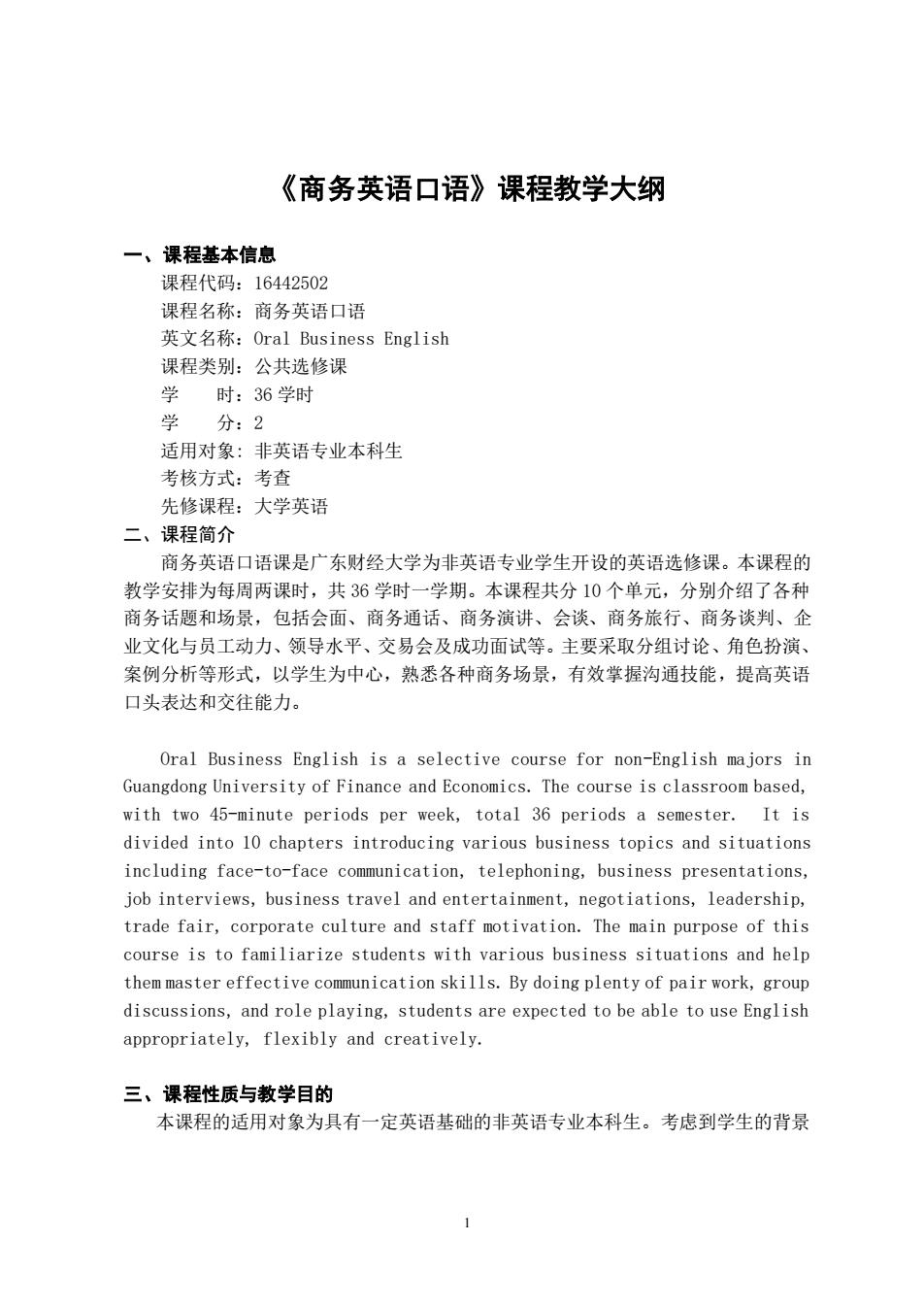
《商务英语口语》课程教学大纲 一、课程基本信息 课程代码:16442502 课程名称:商务英语口语 英文名称:Oral Business English 课程类别:公共选修课 时:36学时 学 分:2 适用对象:非英语专业本科生 考核方式:考查 先修课程:大学英语 二、课程简介 商务英语口语课是广东财经大学为非英语专业学生开设的英语选修课。本课程的 教学安排为每周两课时,共36学时一学期。本课程共分10个单元,分别介绍了各种 商务话题和场景,包括会面、商务通话、商务演讲、会谈、商务旅行、商务谈判、企 业文化与员工动力、领导水平、交易会及成功面试等。主要采取分组讨论、角色扮演、 案例分析等形式,以学生为中心,熟悉各种商务场景,有效掌握沟通技能,提高英语 口头表达和交往能力。 Oral Business English is a selective course for non-English majors in Guangdong University of Finance and Economics.The course is classroom based, with two 45-minute periods per week,total 36 periods a semester.It is divided into 10 chapters introducing various business topics and situations including face-to-face communication,telephoning,business presentations, job interviews,business travel and entertainment,negotiations,leadership, trade fair,corporate culture and staff motivation.The main purpose of this course is to familiarize students with various business situations and help them master effective communication skills.By doing plenty of pair work,group discussions,and role playing,students are expected to be able to use English appropriately,flexibly and creatively. 三、课程性质与教学目的 本课程的适用对象为具有一定英语基础的非英语专业本科生。考虑到学生的背景
1 《商务英语口语》课程教学大纲 一、课程基本信息 课程代码:16442502 课程名称:商务英语口语 英文名称:Oral Business English 课程类别:公共选修课 学 时:36 学时 学 分:2 适用对象: 非英语专业本科生 考核方式:考查 先修课程:大学英语 二、课程简介 商务英语口语课是广东财经大学为非英语专业学生开设的英语选修课。本课程的 教学安排为每周两课时,共 36 学时一学期。本课程共分 10 个单元,分别介绍了各种 商务话题和场景,包括会面、商务通话、商务演讲、会谈、商务旅行、商务谈判、企 业文化与员工动力、领导水平、交易会及成功面试等。主要采取分组讨论、角色扮演、 案例分析等形式,以学生为中心,熟悉各种商务场景,有效掌握沟通技能,提高英语 口头表达和交往能力。 Oral Business English is a selective course for non-English majors in Guangdong University of Finance and Economics. The course is classroom based, with two 45-minute periods per week, total 36 periods a semester. It is divided into 10 chapters introducing various business topics and situations including face-to-face communication, telephoning, business presentations, job interviews, business travel and entertainment, negotiations, leadership, trade fair, corporate culture and staff motivation. The main purpose of this course is to familiarize students with various business situations and help them master effective communication skills. By doing plenty of pair work, group discussions, and role playing, students are expected to be able to use English appropriately, flexibly and creatively. 三、课程性质与教学目的 本课程的适用对象为具有一定英语基础的非英语专业本科生。考虑到学生的背景
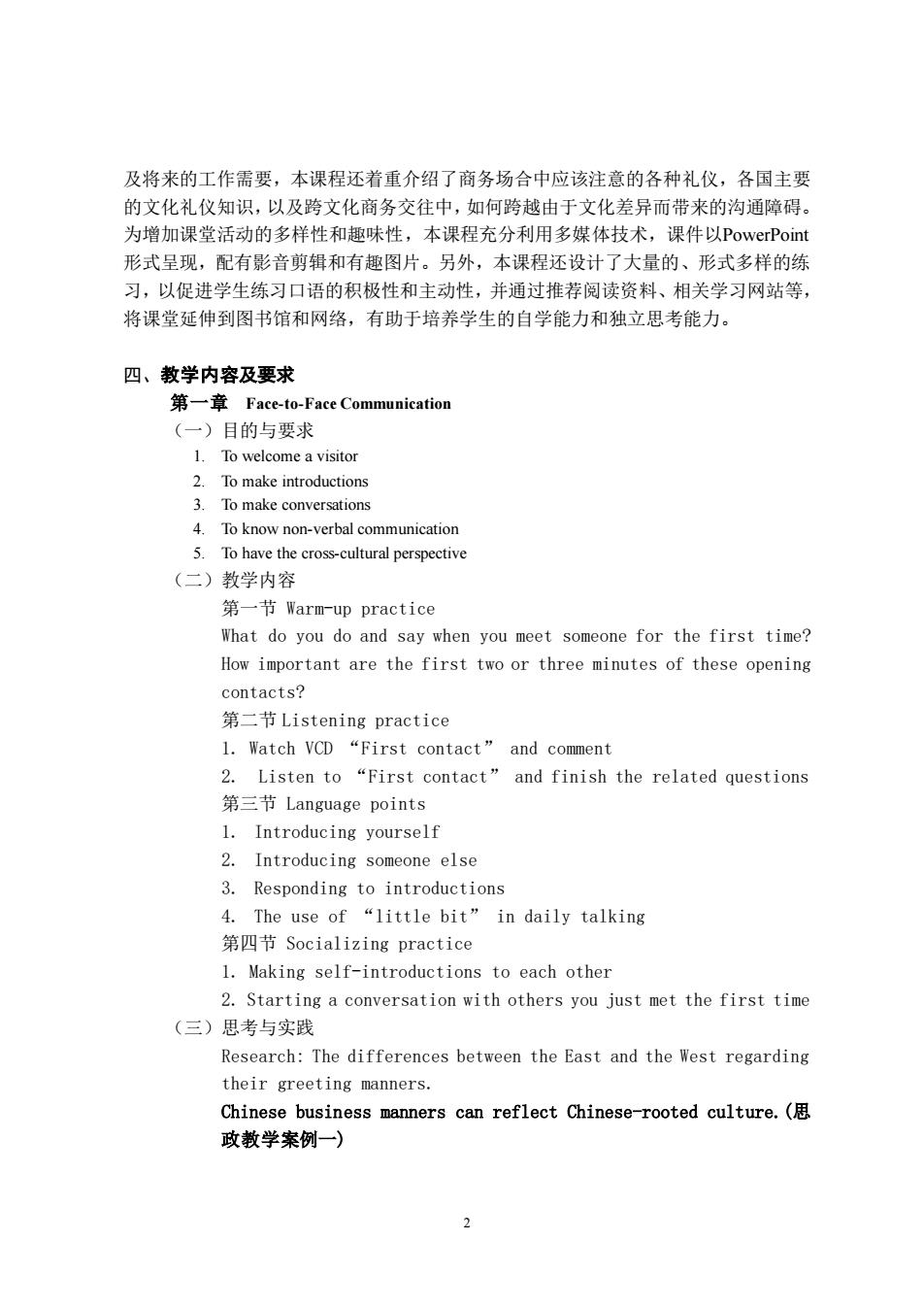
及将来的工作需要,本课程还着重介绍了商务场合中应该注意的各种礼仪,各国主要 的文化礼仪知识,以及跨文化商务交往中,如何跨越由于文化差异而带来的沟通障碍 为增加课堂活动的多样性和趣味性,本课程充分利用多媒体技术,课件以PowerPoint 形式呈现,配有影音剪辑和有趣图片。另外,本课程还设计了大量的、形式多样的练 习,以促进学生练习口语的积极性和主动性,并通过推荐阅读资料、相关学习网站等, 将课堂延伸到图书馆和网络,有助于培养学生的自学能力和独立思考能力 四、教学内容及要求 第一章Face-to-Face communication (一)目的与要求 1.To welcome a visitor 2.To make introductions 3.To make conversation 4. Toknow non-verbal 5.To have the cross-cultural perspective (二)教学内容 第一节Warm-up practice What do you do and say when you meet someone for the first time? How important are the first two or three minutes of these opening contacts? 第二节Listening practice L.Watch VCD“First contact”and comment 2.Listen to“First contact” and finish the related questions 第三节Language points 1.Introducing yourself 2.Introducing someone else 3.Responding to introductions 4.The use of“little bit”in daily talking 第四节Socializing practice 1.Making self-introductions to each other 2.Starting a conversation with others you just met the first time (三)思考与实践 Research:The differences between the East and the west regarding their greeting manners. Chinese business manners can reflect Chinese-rooted culture.( 政教学案例一) 2
2 及将来的工作需要,本课程还着重介绍了商务场合中应该注意的各种礼仪,各国主要 的文化礼仪知识,以及跨文化商务交往中,如何跨越由于文化差异而带来的沟通障碍。 为增加课堂活动的多样性和趣味性,本课程充分利用多媒体技术,课件以PowerPoint 形式呈现,配有影音剪辑和有趣图片。另外,本课程还设计了大量的、形式多样的练 习,以促进学生练习口语的积极性和主动性,并通过推荐阅读资料、相关学习网站等, 将课堂延伸到图书馆和网络,有助于培养学生的自学能力和独立思考能力。 四、教学内容及要求 第一章 Face-to-Face Communication (一)目的与要求 1. To welcome a visitor 2. To make introductions 3. To make conversations 4. To know non-verbal communication 5. To have the cross-cultural perspective (二)教学内容 第一节 Warm-up practice What do you do and say when you meet someone for the first time? How important are the first two or three minutes of these opening contacts? 第二节 Listening practice 1. Watch VCD “First contact” and comment 2. Listen to “First contact” and finish the related questions 第三节 Language points 1. Introducing yourself 2. Introducing someone else 3. Responding to introductions 4. The use of “little bit” in daily talking 第四节 Socializing practice 1. Making self-introductions to each other 2. Starting a conversation with others you just met the first time (三)思考与实践 Research: The differences between the East and the West regarding their greeting manners. Chinese business manners can reflect Chinese-rooted culture.(思 政教学案例一)
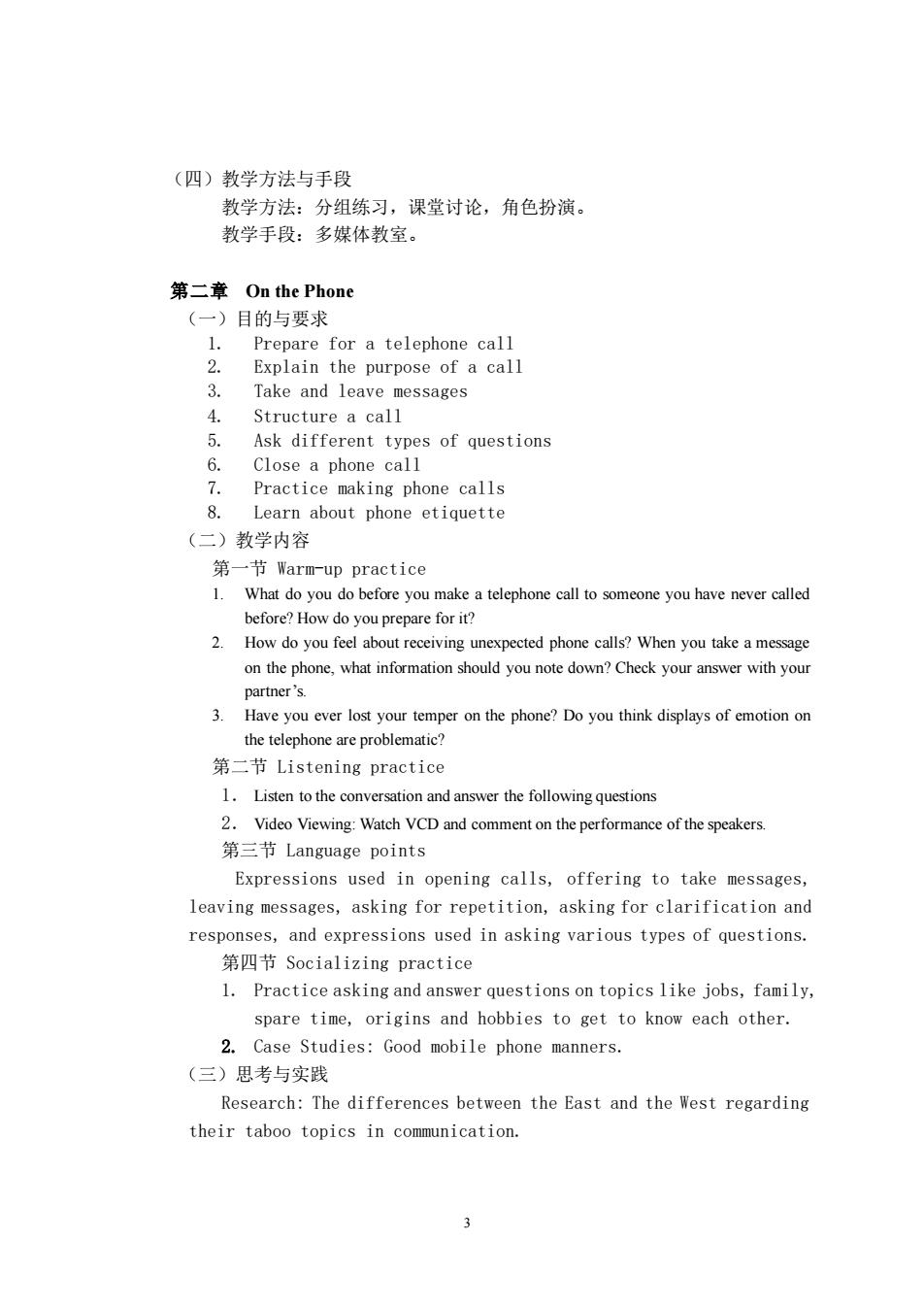
(四)教学方法与手段 教学方法:分组练习,课堂讨论,角色扮演。 教学手段:多媒体教室。 第二章On the Phone (一)目的与要求 Prepare for a telephone call 2.Explain the purpose of a call 3 Take and leave messages Structure a call Ask different types of questions Close a phone call 7. Practice making phone calls 8 Learn about phone etiguette (二)教学内容 第一节Warm-up practice before?How do you prepare for it? 2.How do you feel about receiving unexpected phone calls?When you take a message on the phone.what information should you note down?Check your answer with your partner's. 3. ou ever lost your temper on the phone?Do you think displays of emotion on the telephone are problematic 第二节Listening practice 1.Listen to the conversation and answer the following questions 2.Video Viewing:Watch VCD and comment on the performance of the speakers 第三节Language points Expressions used in opening calls,offering to take messages. leaving messages,asking for repetition,asking for clarification and responses,and expressions used in asking various types of questions. 第四节Socializing practice 1.Practice asking and answer questions on topics like jobs,family, spare time,origins and hobbies to get to know each other. 2.Case Studies:Good mobile phone manners (三)思考与实践 Research:The differences between the East and the West regarding their taboo topics in communication. 3
3 (四)教学方法与手段 教学方法:分组练习,课堂讨论,角色扮演。 教学手段:多媒体教室。 第二章 On the Phone (一)目的与要求 1. Prepare for a telephone call 2. Explain the purpose of a call 3. Take and leave messages 4. Structure a call 5. Ask different types of questions 6. Close a phone call 7. Practice making phone calls 8. Learn about phone etiquette (二)教学内容 第一节 Warm-up practice 1. What do you do before you make a telephone call to someone you have never called before? How do you prepare for it? 2. How do you feel about receiving unexpected phone calls? When you take a message on the phone, what information should you note down? Check your answer with your partner’s. 3. Have you ever lost your temper on the phone? Do you think displays of emotion on the telephone are problematic? 第二节 Listening practice 1. Listen to the conversation and answer the following questions 2. Video Viewing: Watch VCD and comment on the performance of the speakers. 第三节 Language points Expressions used in opening calls, offering to take messages, leaving messages, asking for repetition, asking for clarification and responses, and expressions used in asking various types of questions. 第四节 Socializing practice 1. Practice asking and answer questions on topics like jobs, family, spare time, origins and hobbies to get to know each other. 2. Case Studies: Good mobile phone manners. (三)思考与实践 Research: The differences between the East and the West regarding their taboo topics in communication
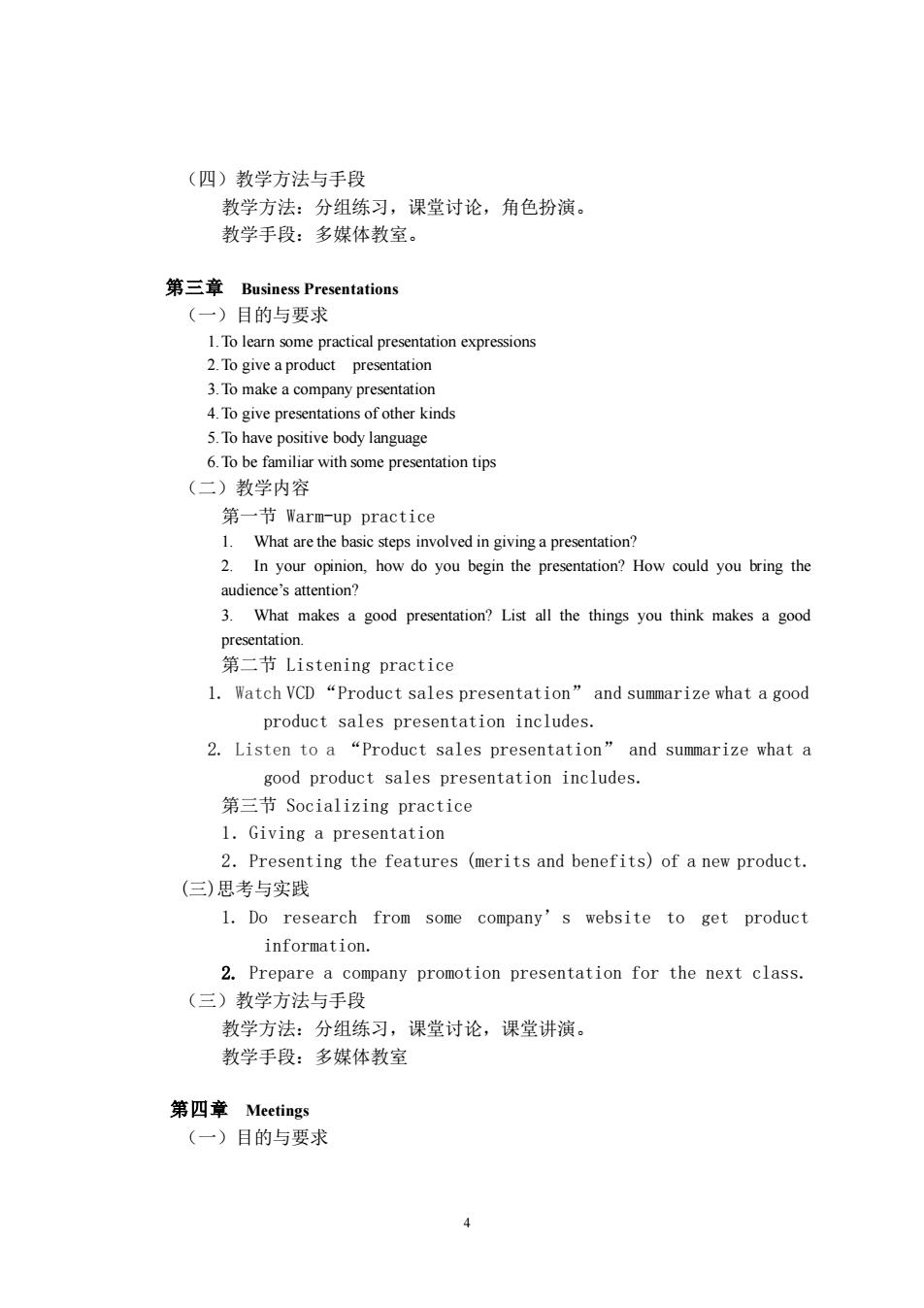
(四)教学方法与手段 教学方法:分组练习,课堂讨论,角色扮演。 教学手段:多媒体教室。 第三章Business Presentations (一)目的与要求 1.Tolearn some practical presentation expressions 2.To give a product presentation 3.To make a company presentation 4.To give presentations of other kinds with some presentation tips (二)教学内容 第一节Warm-up practice What are the bsnod nnrio 2.In your opinion,how do you begin the presentation?How could you bring the audience's attention? 3.What makes a good presentation?List all the things you think makes a good prescntation 第二节Listening practice 1.Watch VCD "Product sales presentation"and summarize what a good product sales presentation includes. 2.Listen to a "Product sales presentation"and summarize what a good product sales presentation includes. 第三节Socializing practice 1.Giving a presentation 2.Presenting the features (merits and benefits)of a new product (三)思考与实践 1.Do research from some company's website to get product information. 2.Prepare a company promotion presentation for the next class. (三)教学方法与手段 教学方法:分组练习,课堂讨论,课堂讲演 教学手段:多媒体教室 第四章Meetings (一)目的与要求
4 (四)教学方法与手段 教学方法:分组练习,课堂讨论,角色扮演。 教学手段:多媒体教室。 第三章 Business Presentations (一)目的与要求 1.To learn some practical presentation expressions 2.To give a product presentation 3.To make a company presentation 4.To give presentations of other kinds 5.To have positive body language 6.To be familiar with some presentation tips (二)教学内容 第一节 Warm-up practice 1. What are the basic steps involved in giving a presentation? 2. In your opinion, how do you begin the presentation? How could you bring the audience’s attention? 3. What makes a good presentation? List all the things you think makes a good presentation. 第二节 Listening practice 1. Watch VCD “Product sales presentation” and summarize what a good product sales presentation includes. 2. Listen to a “Product sales presentation” and summarize what a good product sales presentation includes. 第三节 Socializing practice 1.Giving a presentation 2.Presenting the features (merits and benefits) of a new product. (三)思考与实践 1. Do research from some company’s website to get product information. 2. Prepare a company promotion presentation for the next class. (三)教学方法与手段 教学方法:分组练习,课堂讨论,课堂讲演。 教学手段:多媒体教室 第四章 Meetings (一)目的与要求
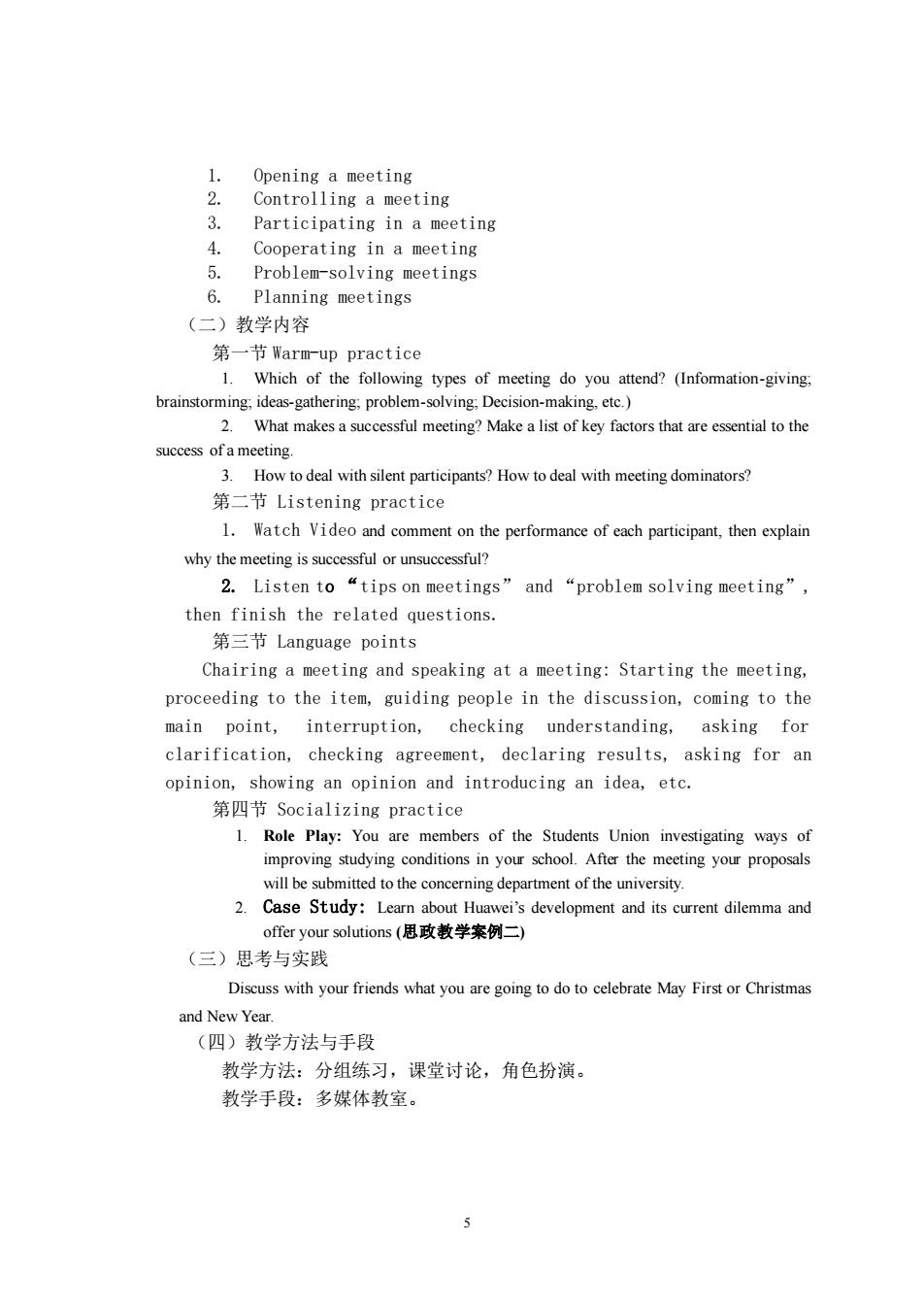
Opening a meeting 2. Controlling a meeting 3. Participating in a meeting 4. in a meeting 5 6. Planning meetings (二)教学内容 第一节War-up practice 1.Which of the following types of meeting do you attend?(Infommation-giving: brainstorming:ideas-gathering:problem-solving:Decision-making.etc.) essful meeting?Make a list of key factors that are essential to the success ofa meeting 3.How to deal with silent participants?How to deal with meeting dominators? 第二节Listening practice 1.Watch Video and comment on the performance of each participant,then explain why the meeting is successful or unsuccessful? 2.Listen to“tips on meetings'”and“problem solving meeting”, then finish the related questions 第三节Language points Chairing a meeting and speaking at a meeting:Starting the meeting proceeding to the item,guiding people in the discussion,coming to the main point, interruption, checking understanding. asking for clarification,checking agreement,declaring results,asking for an opinion,showing an opinion and introducing an idea,etc 第四节Socializing practice 1.Role Play:You re members of the Students Union inv stigating ways of proving stud ing onditions in our school.After the m ing your proposals will be submitted to the concerning department of the university 2.Case Study:Learn about Huawei's development and its current dilemma and offer your solutions(思政教学案例二) (三)思考与实践 Discuss with your friends what you are going to do to celebrate May First or Christmas and New Yea (四)数学方法与手段 教学方法:分组练习,课堂讨论,角色扮演。 教学手段:多媒体教室
5 1. Opening a meeting 2. Controlling a meeting 3. Participating in a meeting 4. Cooperating in a meeting 5. Problem-solving meetings 6. Planning meetings (二)教学内容 第一节 Warm-up practice 1. Which of the following types of meeting do you attend? (Information-giving; brainstorming; ideas-gathering; problem-solving; Decision-making, etc.) 2. What makes a successful meeting? Make a list of key factors that are essential to the success of a meeting. 3. How to deal with silent participants? How to deal with meeting dominators? 第二节 Listening practice 1. Watch Video and comment on the performance of each participant, then explain why the meeting is successful or unsuccessful? 2. Listen to “tips on meetings” and “problem solving meeting”, then finish the related questions. 第三节 Language points Chairing a meeting and speaking at a meeting: Starting the meeting, proceeding to the item, guiding people in the discussion, coming to the main point, interruption, checking understanding, asking for clarification, checking agreement, declaring results, asking for an opinion, showing an opinion and introducing an idea, etc. 第四节 Socializing practice 1. Role Play: You are members of the Students Union investigating ways of improving studying conditions in your school. After the meeting your proposals will be submitted to the concerning department of the university. 2. Case Study: Learn about Huawei’s development and its current dilemma and offer your solutions (思政教学案例二) (三)思考与实践 Discuss with your friends what you are going to do to celebrate May First or Christmas and New Year. (四)教学方法与手段 教学方法:分组练习,课堂讨论,角色扮演。 教学手段:多媒体教室

第五章Business Travel (一)目的与要求 1.To make enquiries 2.To make airline reservations 3.To check in at the airport 4.To go through the security check 5.To go through customs (二)教学内容 第一节Warm-up practice 1. it make if you're on and traveling on business 2.Usually how many days in advance do you need to make a reservation for an air ticket? 3.Tell us the procedures you have to go through when taking a domestic flight?lave yo over takon theon flight?If yes what are the pr es you need t before you get on board the plane?Any differences between them? 第二节Listening practice Listen to the conversation at the airport 第三节Language focus 1.Making enquiries and reservations, 2.Confirming and canceling reservations airpor Going through the Customs 5.Other useful expressions on the plane 第四节Socializing practice Simulation practice on check-in at the airport,going through the Customs 2.Case Studies Read the ltter and consider the two questions 1)Why doyou think the professor became amnoye? What do you think Fran's response to Nancy'squestions will be? (三)思考与实践 Interview some experienced business travelers for advice, experiencing and feelings about traveling on business. (四)教学方法与手段 教学方法:分组练习,课堂讨论,角色扮演。 6
6 第五章 Business Travel (一)目的与要求 1. To make enquiries 2. To make airline reservations 3. To check in at the airport 4. To go through the security check 5. To go through customs (二)教学内容 第一节 Warm-up practice 1. Do you travel a lot? What difference does it make if you’re on holiday (traveling for pleasure) and traveling on business? 2. Usually how many days in advance do you need to make a reservation for an air ticket? 3. Tell us the procedures you have to go through when taking a domestic flight? Have you ever taken the international flight? If yes, what are the procedures you need to go through before you get on board the plane? Any differences between them? 第二节 Listening practice Listen to the conversation at the airport 第三节 Language focus 1. Making enquiries and reservations, 2. Confirming and canceling reservations 3. Checking at the airport 4. Going through the Customs 5. Other useful expressions on the plane 第四节 Socializing practice 1. Simulation practice on check-in at the airport, going through the Customs 2. Case Studies Read the letter and consider the two questions: 1) Why do you think the professor became annoyed? 2) What do you think Fran’s response to Nancy’s questions will be? (三)思考与实践 Interview some experienced business travelers for advice, experiencing and feelings about traveling on business. (四)教学方法与手段 教学方法:分组练习,课堂讨论,角色扮演
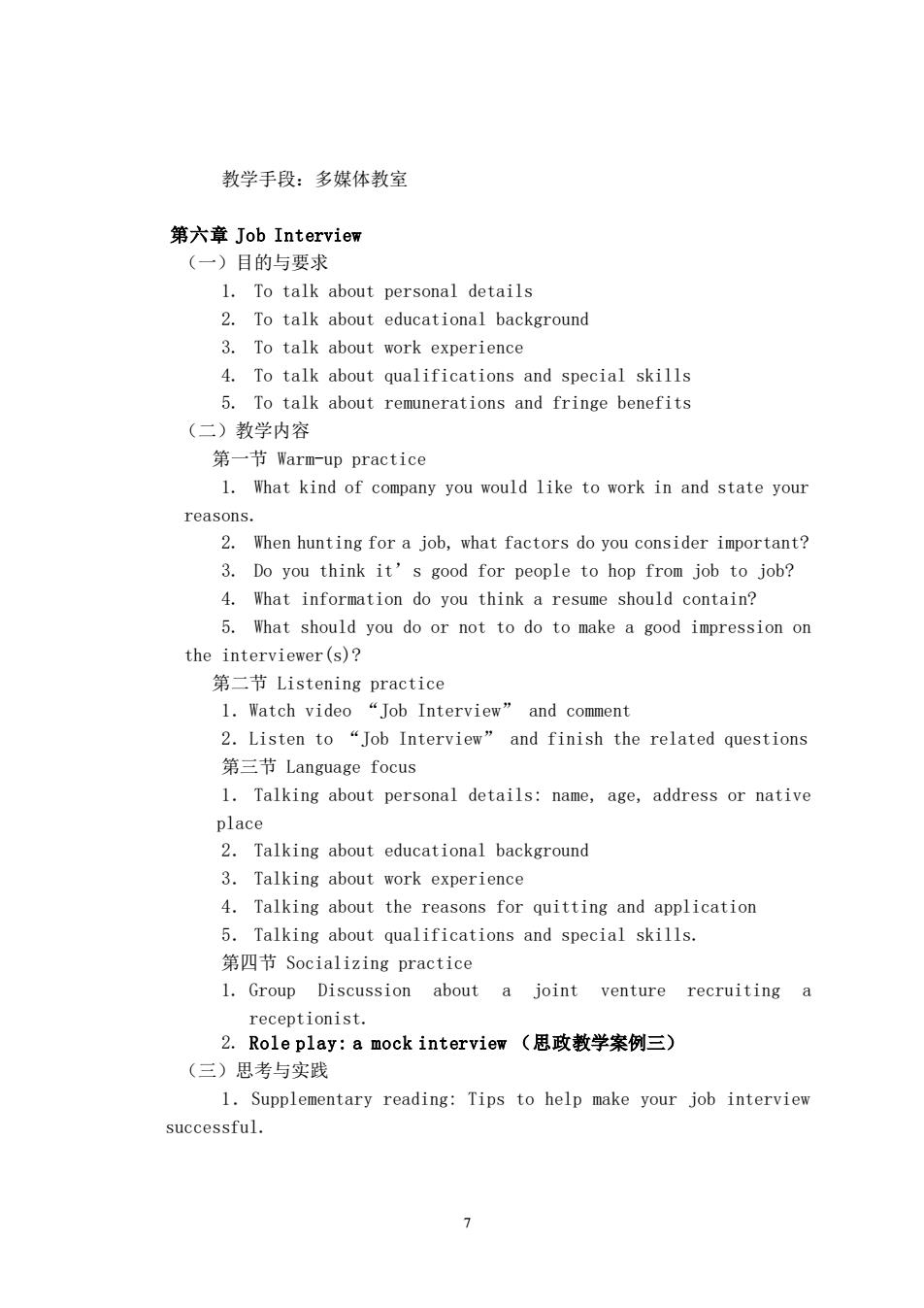
教学手段:多媒体教室 第六章Job Interview (一)目的与要求 1.To talk about personal details 2.To talk about educational background 3.To talk about work experience 4.To talk about qualifications and special skills 5.To talk about remunerations and fringe benefits (二)教学内容 第一节Warm-up practice 1.What kind of company you would like to work in and state your reasons 2.When hunting for a job,what factors do you consider important? 3.Do you think it's good for people to hop from job to job? 4.What information do you think a resume should contain? 5.What should you do or not to do to make a good impression on the interviewer(s)? 第二节Listening practice I.Watch video“Job Interview'”and comment 2.Listen to“Job Interview” and finish the related questions 第三节Language focus 1.Talking about personal details:name,age,address or native place 2.Talking about educational background 3.Talking about work experience 4.Talking about the reasons for quitting and application 5.Talking about qualifications and special skills. 第四节Socializing practice 1.Group Discussion about a joint venture recruiting a receptionist. 2.Role play:a mock interview(思政教学案例三) (三)思考与实践 1.Supplementary reading:Tips to help make your job interview successful
7 教学手段:多媒体教室 第六章 Job Interview (一)目的与要求 1. To talk about personal details 2. To talk about educational background 3. To talk about work experience 4. To talk about qualifications and special skills 5. To talk about remunerations and fringe benefits (二)教学内容 第一节 Warm-up practice 1. What kind of company you would like to work in and state your reasons. 2. When hunting for a job, what factors do you consider important? 3. Do you think it’s good for people to hop from job to job? 4. What information do you think a resume should contain? 5. What should you do or not to do to make a good impression on the interviewer(s)? 第二节 Listening practice 1.Watch video “Job Interview” and comment 2.Listen to “Job Interview” and finish the related questions 第三节 Language focus 1. Talking about personal details: name, age, address or native place 2. Talking about educational background 3. Talking about work experience 4. Talking about the reasons for quitting and application 5. Talking about qualifications and special skills. 第四节 Socializing practice 1. Group Discussion about a joint venture recruiting a receptionist. 2. Role play: a mock interview (思政教学案例三) (三)思考与实践 1.Supplementary reading: Tips to help make your job interview successful
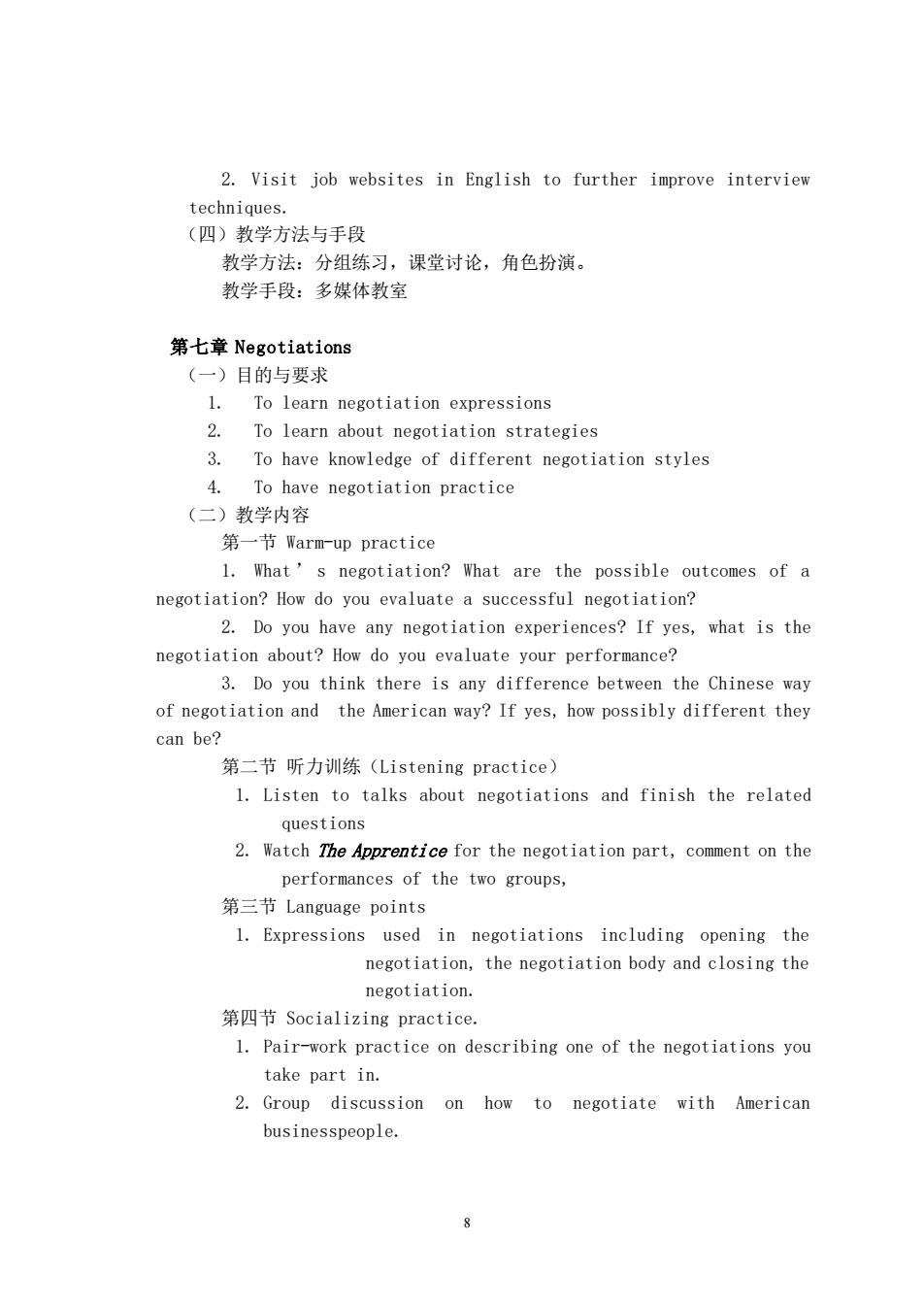
2.Visit job websites in English to further improve interview techniques (四)教学方法与手段 教学方法:分组练习,课堂讨论,角色扮演。 教学手段:多媒体教室 第七章Negotiations (一)目的与要求 1.To learn negotiation expressions 2.To learn about negotiation strategies 3.To have knowledge of different negotiation styles 4 To have negotiation practice (二)教学内容 第一节War-up practice 1.What's negotiation?What are the possible outcomes of a negotiation?How do you evaluate a successful negotiation? 2.Do you have any negotiation experiences?If yes,what is the negotiation about?How do you evaluate your performance? 3.Do you think there is any difference between the Chinese way of negotiation and the American way?If yes,how possibly different they can be? 第二节听力训练(Listening practice) 1.Listen to talks about negotiations and finish the related questions 2.Watch The Apprentice for the negotiation part,comment on the performances of the two groups, 第三节Language points 1.Expressions used in negotiations including opening the negotiation,the negotiation body and closing the negotiation. 第四节Socializing practice,. 1.Pair-work practice on describing one of the negotiations you take part in. 2.Group discussion on how to negotiate with American businesspeople. 8
8 2. Visit job websites in English to further improve interview techniques. (四)教学方法与手段 教学方法:分组练习,课堂讨论,角色扮演。 教学手段:多媒体教室 第七章 Negotiations (一)目的与要求 1. To learn negotiation expressions 2. To learn about negotiation strategies 3. To have knowledge of different negotiation styles 4. To have negotiation practice (二)教学内容 第一节 Warm-up practice 1. What ’ s negotiation? What are the possible outcomes of a negotiation? How do you evaluate a successful negotiation? 2. Do you have any negotiation experiences? If yes, what is the negotiation about? How do you evaluate your performance? 3. Do you think there is any difference between the Chinese way of negotiation and the American way? If yes, how possibly different they can be? 第二节 听力训练(Listening practice) 1. Listen to talks about negotiations and finish the related questions 2. Watch The Apprentice for the negotiation part, comment on the performances of the two groups, 第三节 Language points 1. Expressions used in negotiations including opening the negotiation, the negotiation body and closing the negotiation. 第四节 Socializing practice. 1. Pair-work practice on describing one of the negotiations you take part in. 2. Group discussion on how to negotiate with American businesspeople
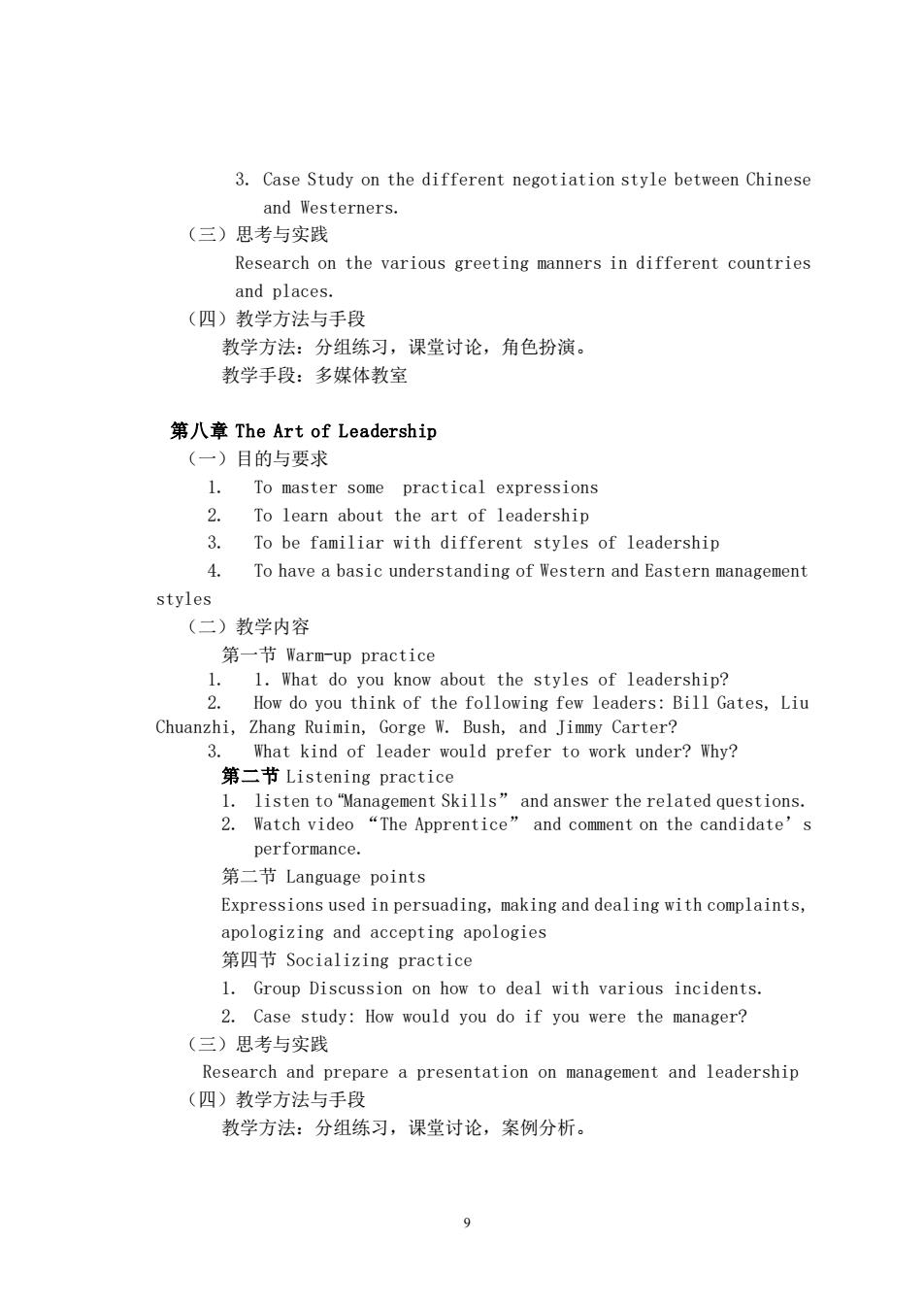
3.Case Study on the different negotiation style between Chinese and Westerners. (三)思考与实践 Research on the various greeting manners in different countries and places. (四)教学方法与手段 教学方法:分组练习,课堂讨论,角色扮演。 教学手段:多媒体教室 第八章The Art of Leadership (一)目的与要求 1.To master some practical expressions 2 To learn about the art of leadership 3. To be familiar with different styles of leadership 4. To have a basic understanding of Western and Eastern management styles (二)教学内容 第一节Warm-up practice 1 1.What do you know about the stvles of leadership? How do you think of the following few leaders:Bill Gates,Liu Chuanzhi, Zhang Rui i Gorge W. Bush, and Jimmy Carter? What kind of leader would prefer to work under?Why? 第二节Listening practice 1.listen to "Management skills"and answer the related questions. 2.Watch video“The Apprentice” and comment on the candidate's performance 第二节Language points Expressions used in persuading,making and dealing with complaints, apologizing and accepting apologies 第四节Socializing practice 1.Group Discussion on how to deal with various incidents. 2.Case study:How would you do if you were the manager? (三)思考与实践 Research and prepare a presentation on management and leadership (四)教学方法与手段 教学方法:分组练习,课堂讨论,案例分析
9 3. Case Study on the different negotiation style between Chinese and Westerners. (三)思考与实践 Research on the various greeting manners in different countries and places. (四)教学方法与手段 教学方法:分组练习,课堂讨论,角色扮演。 教学手段:多媒体教室 第八章 The Art of Leadership (一)目的与要求 1. To master some practical expressions 2. To learn about the art of leadership 3. To be familiar with different styles of leadership 4. To have a basic understanding of Western and Eastern management styles (二)教学内容 第一节 Warm-up practice 1. 1.What do you know about the styles of leadership? 2. How do you think of the following few leaders: Bill Gates, Liu Chuanzhi, Zhang Ruimin, Gorge W. Bush, and Jimmy Carter? 3. What kind of leader would prefer to work under? Why? 第二节 Listening practice 1. listen to “Management Skills” and answer the related questions. 2. Watch video “The Apprentice” and comment on the candidate’s performance. 第二节 Language points Expressions used in persuading, making and dealing with complaints, apologizing and accepting apologies 第四节 Socializing practice 1. Group Discussion on how to deal with various incidents. 2. Case study: How would you do if you were the manager? (三)思考与实践 Research and prepare a presentation on management and leadership (四)教学方法与手段 教学方法:分组练习,课堂讨论,案例分析
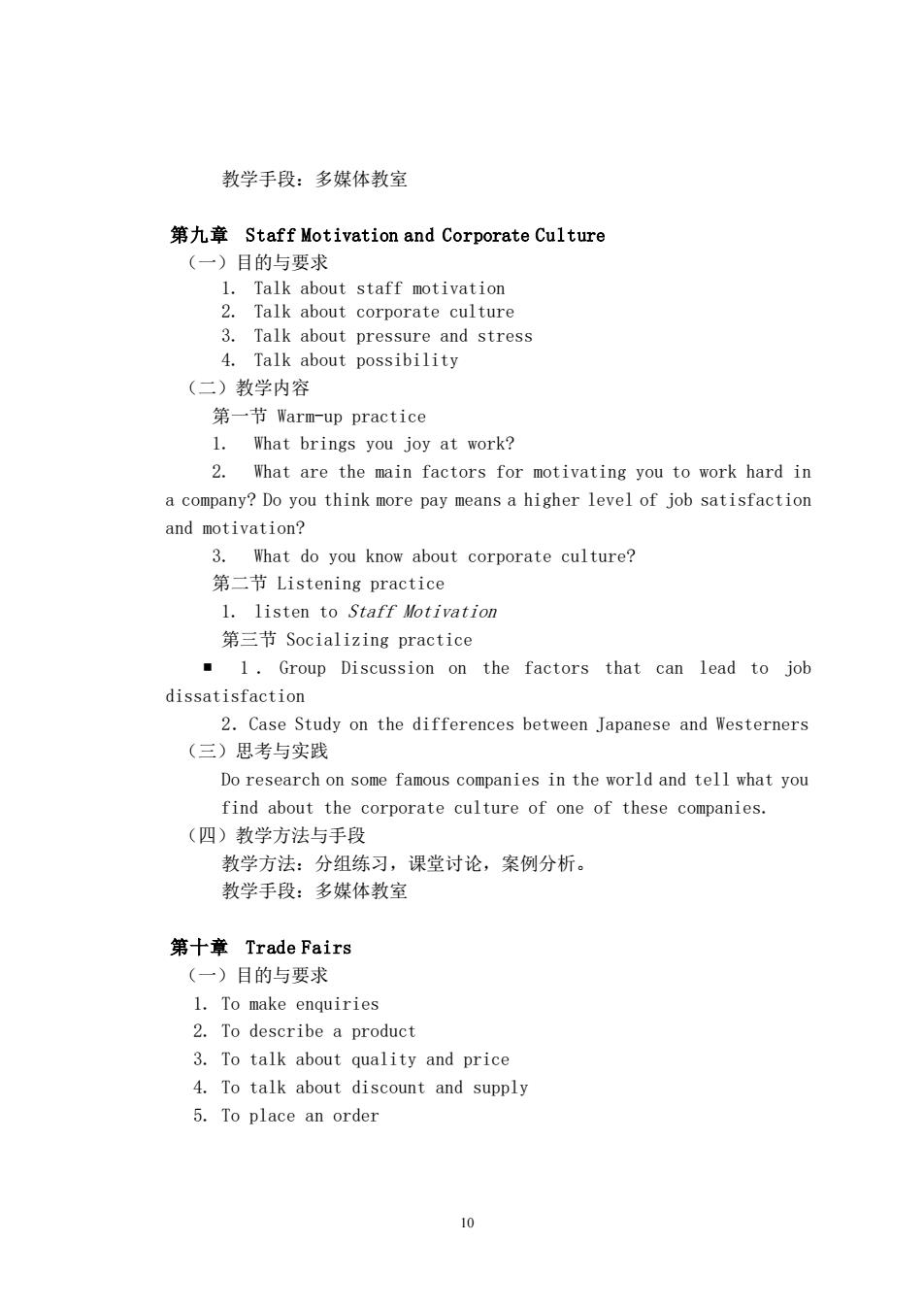
教学手段:多媒体教室 第九章Staff Motivation and Corporate Culture (一)目的与要求 1.Talk about staff motivation 2.Talk about corporate culture 3.Talk about pressure and stress 4.Talk about possibility (二)教学内容 第一节Warm-up practice 1.What brings you joy at work? 2.What are the main factors for motivating you to work hard in a company?Do you think more pay means a higher level of job satisfaction and motivation? 3.What do you know about corporate culture? 第二节Listening practice 1.listen to Staff Motivation 第三节Socializing practice 1.Group Discussion on the factors that can lead to job dissatisfaction 2.Case Study on the differences between Japanese and Westerners (三)思考与实践 Do research on some famous companies in the world and tell what you find about the corporate culture of one of these companies. (四)教学方法与手段 教学方法:分组练习,课堂讨论,案例分析。 教学手段:多媒体教室 第十章Trade Fairs (一)目的与要求 1.To make enquiries 2.To describe a product 3.To talk about quality and price 4.To talk about discount and supply 5.To place an order 10
10 教学手段:多媒体教室 第九章 Staff Motivation and Corporate Culture (一)目的与要求 1. Talk about staff motivation 2. Talk about corporate culture 3. Talk about pressure and stress 4. Talk about possibility (二)教学内容 第一节 Warm-up practice 1. What brings you joy at work? 2. What are the main factors for motivating you to work hard in a company? Do you think more pay means a higher level of job satisfaction and motivation? 3. What do you know about corporate culture? 第二节 Listening practice 1. listen to Staff Motivation 第三节 Socializing practice 1 . Group Discussion on the factors that can lead to job dissatisfaction 2.Case Study on the differences between Japanese and Westerners (三)思考与实践 Do research on some famous companies in the world and tell what you find about the corporate culture of one of these companies. (四)教学方法与手段 教学方法:分组练习,课堂讨论,案例分析。 教学手段:多媒体教室 第十章 Trade Fairs (一)目的与要求 1. To make enquiries 2. To describe a product 3. To talk about quality and price 4. To talk about discount and supply 5. To place an order